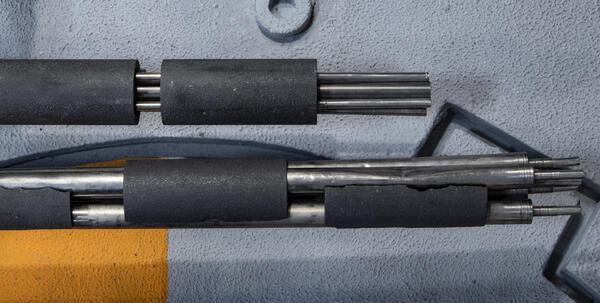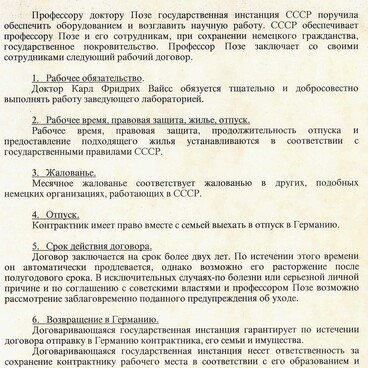The world’s first nuclear power plant was built in the summer of 1954 in the area of what is now Obninsk. It successfully operated for 48 years, which is 18 years longer than the expected service life. The mock-up of a hot tube from the Obninsk NPP is life-size. For visual clarity, it is divided in half and sawed in several places. This unit is designed to generate thermal energy during a nuclear reaction inside the reactor.
A nuclear reactor is a cylinder made up of individual graphite blocks. There are 128 process tubes inserted into the reactor’s core, each containing fuel elements — fuel rods. Their development was one of the most difficult problems faced by the creators of the nuclear reactor. Dozens of professionals worked on it and it was only the version developed by Vladimir Malykh, an employee of the secret Laboratory B, that was implemented. The difficulty was that when heated the uranium would deform, swell and tear the tubes of the fuel assembly. Vladimir Malykh suggested crushing the uranium into coarse grains and pouring it over with molten magnesium. This technology prevented the uranium from swelling, which made it possible to produce the fuel elements needed for the reactor.
The elements do not have a dangerous background radiation until they are immersed in the core of a nuclear reactor. Fuel rods are stainless steel tubes filled with a uranium-based fuel mixture. When a nuclear reactor is filled with fuel rods, a chain reaction of fission of nuclear fuel nuclei begins, during which a large amount of heat energy is released. This energy heats the coolant in the process tubes.
In the nuclear reactor of the world’s first nuclear power plant, water was used as the coolant. Heated to 1,500 degrees Celsius during a nuclear reaction, it became radioactive. The fuel rods held a pressure of a hundred atmospheres, so that the water remained liquid. A nuclear power plant is an economical and, in case of accident-free operation, environmentally friendly way of producing electricity. In order to produce 5,000 kilowatts a day a thermal power station burns 120 tons of coal and releases large quantities of combustion products into the atmosphere. The same power produced by a nuclear power plant requires only thirty grams of uranium.
A nuclear reactor is a cylinder made up of individual graphite blocks. There are 128 process tubes inserted into the reactor’s core, each containing fuel elements — fuel rods. Their development was one of the most difficult problems faced by the creators of the nuclear reactor. Dozens of professionals worked on it and it was only the version developed by Vladimir Malykh, an employee of the secret Laboratory B, that was implemented. The difficulty was that when heated the uranium would deform, swell and tear the tubes of the fuel assembly. Vladimir Malykh suggested crushing the uranium into coarse grains and pouring it over with molten magnesium. This technology prevented the uranium from swelling, which made it possible to produce the fuel elements needed for the reactor.
The elements do not have a dangerous background radiation until they are immersed in the core of a nuclear reactor. Fuel rods are stainless steel tubes filled with a uranium-based fuel mixture. When a nuclear reactor is filled with fuel rods, a chain reaction of fission of nuclear fuel nuclei begins, during which a large amount of heat energy is released. This energy heats the coolant in the process tubes.
In the nuclear reactor of the world’s first nuclear power plant, water was used as the coolant. Heated to 1,500 degrees Celsius during a nuclear reaction, it became radioactive. The fuel rods held a pressure of a hundred atmospheres, so that the water remained liquid. A nuclear power plant is an economical and, in case of accident-free operation, environmentally friendly way of producing electricity. In order to produce 5,000 kilowatts a day a thermal power station burns 120 tons of coal and releases large quantities of combustion products into the atmosphere. The same power produced by a nuclear power plant requires only thirty grams of uranium.



